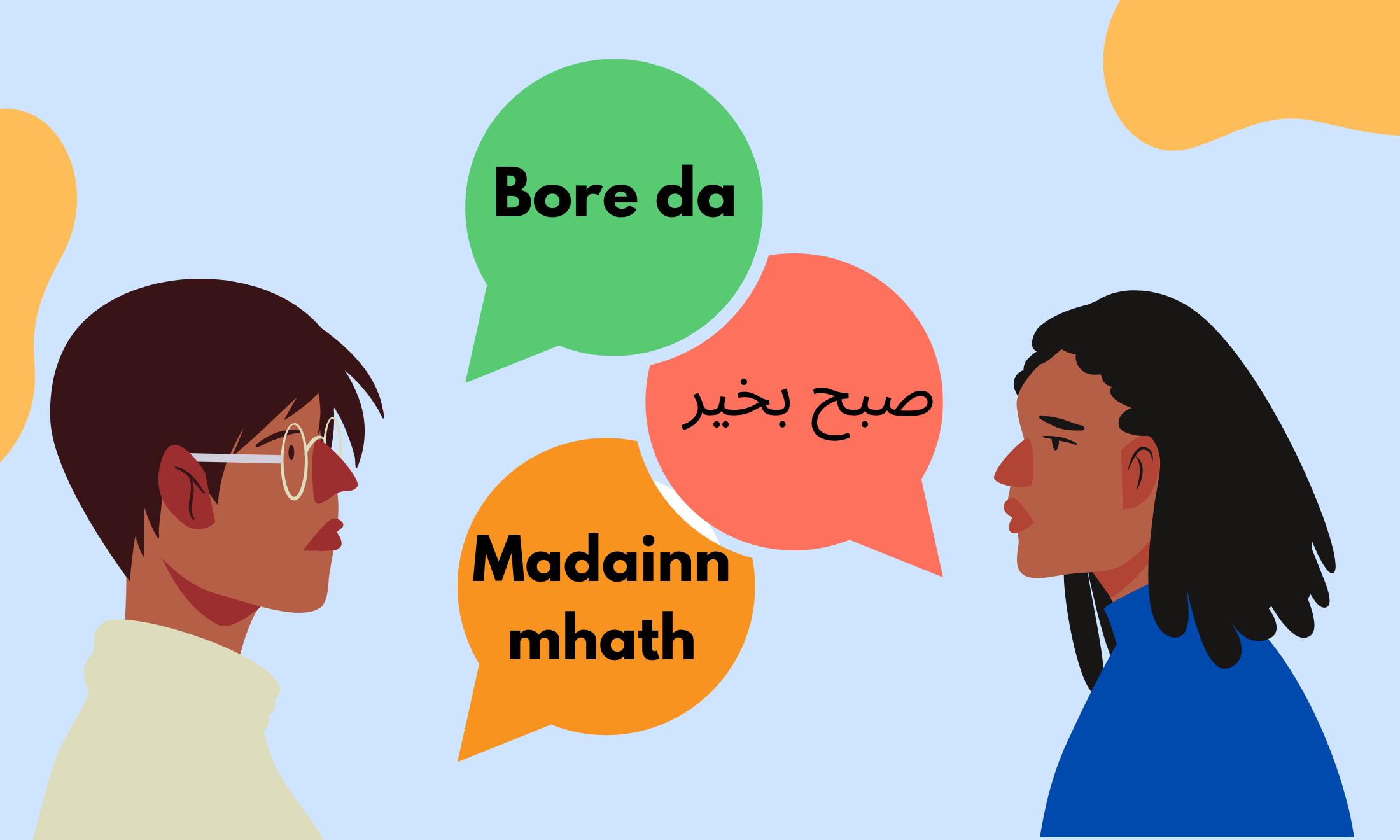How Westminster neoliberalism discourages people across Britain from learning their mother tongues
A policy that only values languages according to perceived economic benefit threatens British language learning across the board.
Nayonica Ghosh
21 Feb 2021

Canva
In February 2014, part-time politician and full-time spouter of rubbish Nigel Farage began complaining that he felt “awkward” when he didn’t hear English being spoken in public places. “In many parts of England you don’t hear English spoken any more,” Farage claimed.
It was nonsense of course. The English language is in no danger of disappearing from these shores any time soon. Of the roughly 66 million people who live in Britain, 98% can speak English. But as English speakers grow, the indigenous languages within the so-called ‘British Isles’ are in danger of extinction. So how did we get here?
Among the 189 islands that make up the likes of Scotland, Ireland, England and Wales, there are seven indigenous languages that face being lost to future generations. Cornish, Scottish-Gaelic, Ulster Scots, Manx and Irish Scots are all “endangered” tongues, despite efforts made to revitalise them in the present day. Examining the causes behind their slow disappearance shows a pattern. Westminster’s historical neglect of these indigenous British languages mirror a similar disregard for the 300 “foreign” languages that make up multicultural Britain, but have been deemed of low value to learn by a xenophobic elite.
“In 1989 Margaret Thatcher’s government blocked the expansion of Sottish-Gaelic television as advisors didn’t want to ‘impose’ the language on people”
As of 2019, only 1.1% of Scottish people speak Scottish Gaelic (approx. 55,000 people in a population of five million) and 14.5% of Welsh people can speak, read and write Welsh. (188,000 people out of a population of around 3 million). The scarcity of indigenous language speakers today is a residual consequence of historical language bans by Tudor monarchs, dating back to the 16th century. These laws prohibited citizens from speaking indigenous languages in public offices, courts and schools. Campaigns to reverse these laws, starting with the 1967 Welsh Language Act, only began in the 20th century.
Adding to this was the onset of the Industrial Revolution from the late 1700s onwards, which triggered the movement of English people to industrial regions such as the Isle of Man, Wales and Cornwall, causing English to eventually become the dominant tongue over indigenous languages. At first it seemed as if bilingualism would be the eventual outcome of the clash of tongues; in 1911 Wales recorded a record high of 977,000 Welsh speakers, attributed to the descendants of Industrial Revolution workers who had learned the language. But by 1921, the number of Welsh speakers was in decline again, reduced to 922,000, perhaps caused by population loss after the First World War. With the official launch of the BBC in Wales in 1922, English-language broadcasting increased, with Welsh-language programmes few and far between until 1945.
A similar story played out in Scotland during the 20th century. Declassified government papers revealed that in 1989, Margaret Thatcher’s government blocked the expansion of Sottish-Gaelic television (necessary to bring the language to the mainstream) as advisors didn’t want to “impose” the language on people. It wasn’t until the 2005 Gaelic Language Act, that equal status for Scottish Gaelic and Scots was passed, with Welsh only granted official language status in 2011.
The language of neoliberalism
Westminster’s reluctance to fund and encourage the revival of languages indigenous to the UK can be understood as a consequence of adopting a neoliberal approach to education. It’s one which has seen the UK language curriculum overhauled based upon the potential financial benefit that learning certain tongues might have for UK nationals. It’s the same approach that has seen certain foreign languages devalued, with both native speakers and would-be learners dissuaded from taking up tongues like Punjabi or Yoruba. In the eyes of the UK government, languages are merely vehicles for economic growth.
The categories of languages that can be studied in English schools, for example, are “modern” languages and “community” languages. Modern refers to any language that’s not ancient (usually existing prior to the 5th century), but in practice means European languages from white-majority countries, like Russia, German and French, as defined by the Collins and Cambridge dictionaries. The national curriculum uses the term “modern languages” to refer to compulsory languages taught to children between the ages of seven to 14, while “community languages” refers to any of the heritage languages – like Punjabi or Urdu – spoken in the UK.
Since the introduction of the national curriculum in 1988 the government has, in theory, embraced the idea of community and modern languages being taught alongside each other, but in practice there have been mixed messages. In 2020, the Department for Education expressed concerns about community languages being “undervalued”.
“Westminster’s reluctance to fund and encourage the revival of languages indigenous to the UK can be understood as a consequence of adopting a neoliberal approach to education”
In Britain, the incentive given to pupils to study languages is employability. The 2004 curriculum emphasised the business benefits of languages and Westminster regularly publishes reports about the cost of monolingualism. EU membership required all schools to teach any one of the 24 working languages spoken in its member states, but for years, the most popular languages were French, German and Spanish, which also – non-coincidentally – happen to be the most in demand business languages.
The 1985 Swann report was in favour of community languages being integrated into school timetables with the same status as modern languages. “We would hope to see a growing number of pupils seeing these languages as a realistic choice for them,” one Swann extract stated, and advised that the demand to study these languages would not solely come from native speakers, but students fresh to the tongues too. There were intentions of trialling this in schools; however the employability focus made schools reluctant to offer them.
Many of the UK’s most spoken languages, such as Lithuanian and Tagalog (which have 85,000 and 70,000 speakers in England and Wales respectively) have been left behind by exams boards. In 2014, the exam board OCR scrapped its ‘Asset’ qualification which assessed 25 languages – including Yoruba, Somali and Cantonese – due to low uptake from schools, leaving students of these languages without the option of formal qualification and making them less likely to be studied in the first place. This decision came due to the coalition government prioritising league table performances determined by GCSEs and A levels. The result of reduced formal language learning opportunities is that, in a country where only one in six primary school children are bilingual, only 32% of Britons aged 15-30 can read or write in a second language (compared to 65% of Europeans). A poll from the Guardian found that a quarter of school children hadn’t ever studied their mother language formally because it hadn’t been offered in school.
Moreover, in 2002, the year I started school, the home secretary, David Blunkett recommended South Asians speak English at home, supposedly to better “integrate”. This wasn’t a legal instruction, but schools took it to be. My parents and their South Asian friends, all first generation immigrants, around the country were identified and told by teachers that for their children to succeed at school they should only be speaking English.
Nurturing a new generation
The view that languages are vehicles for economic growth hasn’t changed. As China has emerged as a significant economic power, Westminster’s interest in cultivating Mandarin speakers has grown. In 2015, chancellor George Osbourne in 2015, allocated £10m to learning Mandarin with the target of 5000 pupils studying it by 2020.
With goals this specific, there is no room to nurture community and indigenous languages. Such state-sponsored messaging has, naturally, caused people to undervalue their linguistic ability. A 2014 study found that 40% of pupils don’t believe knowing their mother tongue is an advantage, and a 2015 YouGov poll found that only 27% of Cardiff University students thought compulsory Welsh is beneficial to continue learning past primary school
Many of the initiatives preserving our indigenous languages were funded by the EU. with Brexit meaning further funding will depend on the UK government. Unfortunately Westminster has proven reluctant to fulfil this duty toward England’s indigenous languages in the past; for example in 2016 all funding for the Cornish language was removed, just as it had been resurrected from extinction.
“State-sponsored messaging has, naturally, caused people to undervalue their linguistic ability. A 2014 study found that 40% of pupils don’t believe knowing their mother tongue is an advantage”
For languages that fall under the jurisdiction of the devolved administrations, there is a much stronger commitment to preservation. In 1999, the year Wales was devolved powers, GCSE Welsh was made compulsory across both English and Welsh medium schools in Wales. Similarly, Scotland has seen a gradual increase in the number of pupils opting to study at one of the five Scottish-Gaelic medium schools. In 2018 4,300 Scottish children undertook their schooling in Gaelic.
Although the number of students choosing to take is Scottish-Gaelic at higher and advanced level is still low (only 271 pupils were entered for qualifications in the language in 2017) the protected status of Gaelic ensures that qualifications will still be offered in spite of low uptake and allows for this number to increase as Scotland’s planned provisions of Gaelic and Gaelic medium teaching widen. In England, Cornish GCSE’s were discontinued due to the lack of candidates in 1996, however the Cornish Language Board (an organisation supported by the Cornwall council) offers accredited qualifications, assessing less than 100 candidates each year and producing their own learning resources.
Looking to the future
The Brexit campaign revealed that young people in Britain do recognise the value of accessible language learning opportunities. Thousands of people campaigned to protect the Erasmus scheme, an EU funded cultural exchange programme that allows university students to study and work abroad and provides tuition in the host country’s tongue. Lockdown has appeared to renew people’s interest in picking up a language. A survey by the British Council found that 10% of adults returned to a language during the spring lockdown and language apps such as Duolingo welcomed an 132% increase in new users in the past year, although Duolingo’s most popular courses remain Spanish, French, German, Italian and Japanese, with community and indigenous British languages missing out.
Looking to the future, there’s hope that indigenous and community languages alike will be afforded the respect and revitalisation they deserve. Initiatives run by local organisations, such as the Manx music festival and Penzance Cornish Language festival, are ensuring generational pride in the indigenous language is being passed down. Targets are being set too; in Wales the current language strategy aims to have one million Welsh speakers by 2050, while Scotland also hopes to increase the number of Gaelic medium schools by 2024. But rising xenophobia and a lack of similar initiatives for the ‘foreign’ languages heard on Britain’s streets that don’t come from majority-white countries, means that the grassroots effort to save community languages faces an uphill battle. It seems that many tongues will remain tied for the near future.
This article was amended on 21 February to state that the population of Wales is around 3 million. An earlier version mistakenly said the population was around 13 million.

Britain’s policing was built on racism. Abolition is unavoidable

How Pakistan’s Khwaja Sira and transgender communities are fearing and fighting for their futures

Their anti-rape performance went viral globally. Now what?






